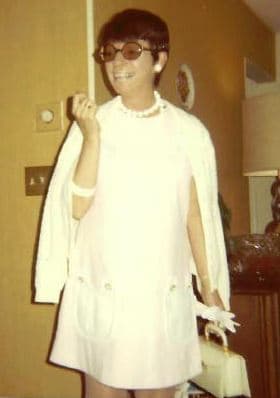Advertisement
The Remembrance Project: Louise Finocchio
Resume"Two roads diverged in a yellow wood,
And sorry I could not travel both."
Louise Finocchio loved that Robert Frost poem. She also loved art and travel. As one of the ground-breaking first female buyers for Filene’s, she roamed internationally, following the paths of fashion and color.
"There’s a picture of her going into a baby shower when she was pregnant with me, and she had these big white-framed glasses and white gloves and a shift dress that was pink with little pockets and a white patent leather purse. She looks exactly like Audrey Hepburn," remembers her daughter, Karen Finocchio Lubeck.

After she became a wife and mother, Lulu—as her family called her—opened an interior design business, written up in "House and Gardens."
"She was so incredibly detail-oriented that when we started to see some shifts in that, that was really the light bulb that started to go on," Karen recalls. "She would call me multiple times a day, without any kind of reference to our conversation earlier. And in some cases, you know, it would be, five phone calls in an hour and a half."
Lulu was 59 when she was diagnosed with early Alzheimer’s disease.
"Mom was terrified. Here you have this brilliant, sharp, driven business owner. She ran a phenomenal interior design business, and she knew she was losing her mind," Karen remembers. "One of the things that we did say from the very first day she was diagnosed: we’re going to keep her home at all costs—that’s what we committed to my mom."
As Lulu had scoured the world of fashion options, Karen and her father scoured the world of clinical options. For the first ten years, that meant medication trials—many medications.
"We went through a time where she was horribly combative, which is very common with Alzheimers, but as only my mom could be combative, she has to take it to a whole new level—not only is she combative, she could have easily taken out, like, Mayweather and Tyson in one go," remembers Karen.
She was on 31 unsuccessful meds when an in-patient doctor suggested electroconvulsive therapy.
"Even after the very first ECT treatment, all of a sudden, that loving, hugging, funny mom was back. She was making words, she was able to start to use words again to communicate—maybe not full sentences, but words," remembers Karen. "She was loving. She would come up to you and instead of, you know, looking like she was gonna knock you out, she would just rub your cheek. She’d come and she’d smile. Nothing, nothing beat my mom’s smile."
Lulu left the hospital on a single drug, for sleep. She stayed on it, along with maintenance ECT, for the next ten years: "Miraculous Patient #11" in studies, grant applications and conference presentations.
"She would just continue to show people that you can live and be happy with Alzheimer’s, as hard as it is," recalls Karen. "And that was her kind of career, was to start to change minds."
"Two roads diverged in a wood, and I—
I took the one less traveled by,
And that has made all the difference."
Did you know Louise Finocchio? Share your memories in the comments section.